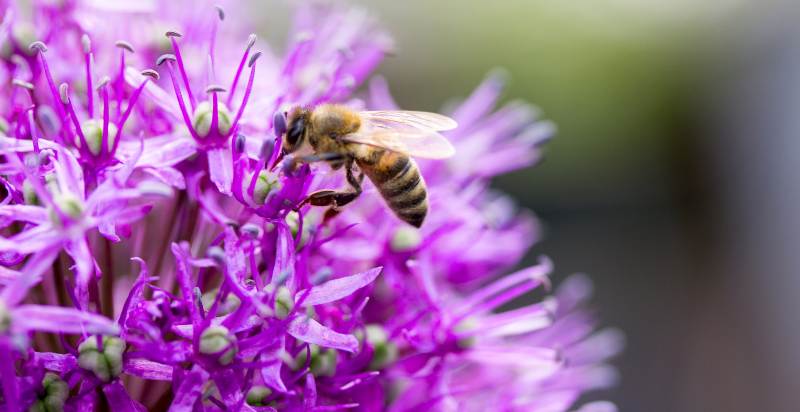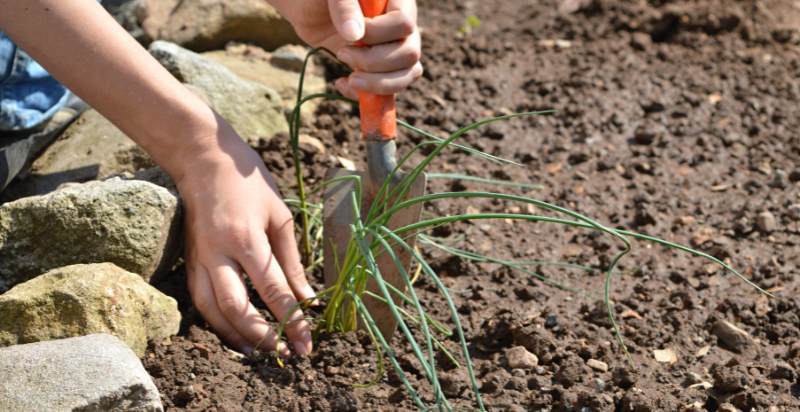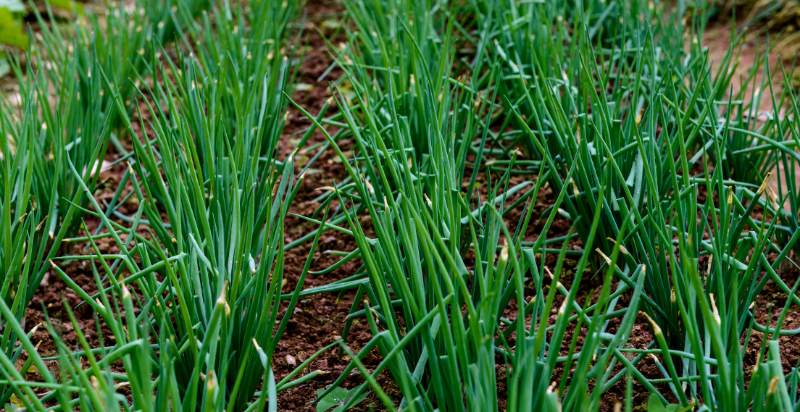Chive plants are a type of herb commonly used in cooking. They have been grown for centuries and can be found in every corner of the world. Chives are members of the Allium family, which also includes garlic and onion.
Chives are known for their mild yet distinctive flavor, as well as their ability to add color and texture to a variety of dishes. In this article, we will look at the history and uses of chive plants and how to grow them in your garden or indoors.
What are Chives Plant?
Chive plants are a type of herb with a long, thin stem and small flowers. The leaves have a mild onion-like taste and can be used fresh or cooked. The edible blooms of the chive plant have a mild onion flavor and are often served as decorations on salads, soups, and eggs. Chives grow in clumps of hollow cylindrical stems that reach heights of 20 to 60 cm (8 – 24 inches).
Types of Chives Plant?
Chives are available in several varieties. Common chives (Allium schoenoprasum) have flat, green leaves, and an oniony flavor. Garlic chives (Allium tuberosum), also known as Chinese chives, look similar to common chives but have a garlic-like flavor. Giant Siberian Chives (Allium ledebourianum) are much taller than the other two types, reaching heights up to 1 meter (3 feet).
History of Chives Plant:
Chives have been used throughout much of human history. Evidence suggests that the ancient Egyptians were growing them over 5,000 years ago. In the Middle Ages, chive plants were used as medicinal herbs and for their ability to repel insects. They were also grown in many monasteries and homes throughout Europe. Today, chives are a popular ingredient in dishes worldwide, from Asian stir-fries to European soups and stews.
Description of Chives Plant:
Chives have a mild onion flavor and can add color and texture to dishes. The leaves are thin, hollow tubes ranging from light green to dark green. The small star-shaped flowers of the plant have an edible lavender or white color. Chive plants require full sun and moist, well-drained soil.

Where Do Chives Plant Grow?
Chives are native to many parts of Europe, Asia, and North America. They prefer moist soil that is either sandy or loamy in texture. Chives will grow well in containers when given partial sun exposure for a few hours each day.
Health Benefits Of Chives:
Chives are not only a tasty addition to your meal, but they also can provide numerous health benefits. Chives contain various essential vitamins and minerals that can help boost your overall health. Additionally, chives have powerful antimicrobial and antimicrobial properties, making them a great option for helping to protect against common illnesses like colds, flu, and bacterial infections.
Chives are a rich source of vitamin C, which is beneficial for maintaining healthy skin, hair, and nails. Vitamin C also helps boost your body’s immunity to illnesses and can help reduce the risk of certain cancers.
Chives are also a great source of antioxidants, which help fight free radicals in the body and protect against cell damage. Chives are also a good source of dietary fiber, which helps keep your digestive system functioning properly and can help lower cholesterol levels. Additionally, chives contain high amounts of certain B vitamins, such as folate, riboflavin, thiamine, and niacin. These B vitamins help the body produce energy, maintain healthy skin, and promote proper mental health.
Uses of Chives Plant:
Chives are often used as an edible garnish for salads, eggs, potatoes, sauces, and other dishes. However, they can also flavor cheese spreads and jars of butter. When cooked briefly with butter or oil, they become sweet and mild-tasting; when cooked longer, they become more pungent. Chives are also packed with essential vitamins and minerals, making them a nutritious addition to any meal.
How to Plant and Grow a Chives Plant?
Planting chives is easy and rewarding. Start preparing your soil; mix in plenty of compost or other organic matter to ensure good drainage and moisture retention. Sow the seeds directly into the ground, spaced around 10 cm apart in rows. Keep the soil moist but not waterlogged while they sprout, usually taking around seven to 14 days to germinate. When seedlings emerge, thin them out, so plants are about 25 cm apart.
Chive plants can be grown in sunny or partly shaded areas and do best when watered regularly—about once a week during dry periods should be sufficient as long as you have well-drained soil with good organic content. Chives also benefit from an occasional feeding of general-purpose fertilizer but don’t overdo it.
Chive plants are herbaceous perennials and survive in most areas even after a hard winter. In very cold climates, however, they may need extra protection or not survive. In such cases, you can dig up and pot the chives in late fall and overwinter them indoors. When spring comes, replant them in the garden.

How To Care For A Chives Plant?
The best way to care for your chive plants is to keep them well-watered and fertilized. If you live in a region with a milder climate, you may not need to water chives as often. Keeping the soil consistently moist during late fall and early winter months is important if your region has colder winters.
Fertilize your chive plants with organic fertilizer or compost tea every few weeks. Doing this will help ensure the plants have adequate nutrition for lush foliage growth and healthy blooms each season.
Chives are susceptible to rust fungus, so keep them well-spaced apart to allow for good air circulation. In some climates, they may also benefit from being mulched with a light layer of straw or other organic material in late fall. Trick off any dead or overgrown foliage as needed to keep your chive plant looking its best all season long. This will help prevent the spread of disease and keep plants looking neat.

Preventions From Pests and Diseases:
Chive plants are relatively pest-free but can be at risk of slug and snail damage in wet climates. Handpicking and setting out traps or baits can help reduce their numbers. Aphids and other soft-body insects may also affect your chives; they are best managed with a combination of manual removal and natural treatments such as neem oil.
Chives are susceptible to rust diseases if the soil is too wet, so ensure that your chive plants get adequate drainage. Applying an organic fungicide can also help prevent rust from taking hold. Keeping plants properly spaced apart will also promote good air circulation, which further aids in disease prevention.

Harvesting Chives:
Once your chive plants are established, you can begin harvesting their leaves when they reach around 10 cm in height. Snip off what you need using scissors or a sharp knife, leaving at least 5 cm of stem remaining on each plant so it can regrow quickly. You can also harvest blooms for use in floral arrangements if desired. For the best flavor, harvest early in the morning before temperatures rise. When stored properly, fresh-cut chives should last about three to five days in the refrigerator—be sure to wrap them tightly in plastic or an air-tight container.
Some Additional Tips For Chives Plant:
- Chive plants are often grown as companion plants in vegetable gardens, as they are said to help deter certain pests.
- If you have an abundance of chives, try drying or freezing them for later use.
- To promote lush foliage growth, trim off the flower heads when they begin to form. This will also keep them from spreading too quickly and becoming invasive.
- For extra flavor and color, consider growing other edible herbs such as parsley, basil, thyme, oregano, or dill near your chive plants. Doing this can also help prevent some common garden pests like aphids from taking hold.
- If you’re looking for a more decorative touch, consider interspersing edible flowers like nasturtiums or pansies with your chive plants. These also attract beneficial insects to the garden, which help keep pests in check.
- If you don’t have a garden, consider growing chives in containers on your balcony or patio. Make sure the containers are large enough for proper root growth and drainage. Container-grown chives need more frequent watering than those planted directly into the ground.
By following these tips, you can ensure that your chive plant is healthy and productive for many seasons!
How To Store Homegrown Chive Plants?
The best way to store homegrown chive plants is to dry them in a cool, dark place for about two weeks. Once the leaves are completely dry and crumbly, you can store them in an airtight container or jar away from direct sunlight. Dried chives will last up to six months when stored this way. You can also freeze chopped chives in ice cube trays before transferring them to an airtight container and storing them in the freezer for up to 12 months. No matter which method you choose, ensure that your storage methods keep out moisture and light as much as possible.
With proper care, harvesting, and storage techniques, homegrown chives can be enjoyed year-round! Whether fresh or dried, chives will surely add delicious flavor and aroma to any recipe. Enjoy!
How To Use A Chive Plants?
Chives can be used in various ways, from garnishing dishes to flavoring sauces and dressings. Raw chives are best when added at the end of cooking to allow their delicate flavor to shine. To maximize their flavor and aroma, try adding them just before serving. You may need to adjust the amount accordingly when using dried chives since they are substantially more potent than fresh chives.
Chives also make an excellent addition to omelets, potatoes, salads, soups, and other cooked dishes. They pair particularly well with eggs, fish, poultry, and vegetables. Chive blossoms are especially lovely when used as a garnish on salads or atop grilled meats and vegetables. However you decide to use them, you’re sure to enjoy the delicate flavor and aroma that homegrown chives can bring!
Finally, remember also to use flower heads as edible decorations. Chive blossoms are beautiful and have a mild onion-like flavor, which can add a delightful contrast to dishes. Remove any excess petals before serving for the best results. Enjoy!
By following these tips and tricks, you should be able to make the most out of your homegrown chive plants! With proper harvesting techniques, storage methods, and creative ways to utilize this aromatic herb in all your favorite recipes, it’s no wonder why chives have been beloved for centuries! Bon Appétit!

Potential Risks From Chives :
Chives do have some potential risks associated with them. First and foremost, chives contain small amounts of oxalates, which can be detrimental for those who suffer from kidney stones or gallbladder issues. Oxalates bind to minerals in the body and are then excreted through urine. This can lead to an accumulation of these compounds if ingested in large quantities.
It is also important to note that chives contain a compound called allicin, which can irritate when consumed in large amounts. Allicin is also found in garlic and has been known to cause stomach upset or even allergic reactions when eaten too much. To reduce the risk of these side effects, it is best to stick to small amounts of chives when adding them to recipes.
Finally, chives may contain hidden contaminants such as pesticides or other chemicals from the soil. To reduce this risk, it is best to source your chives from an organic supplier and wash them thoroughly before consuming them.
By taking these potential risks into account, you can ensure that you enjoy your homegrown chives safely and responsibly!
Conclusion
Chives are an incredibly versatile herb that can be added to various dishes, from salads to sauces. With proper harvesting, drying, and storage techniques, you can enjoy the intense flavor of homegrown chives year-round! To further maximize their flavor and aroma, add them near the end of cooking or just before serving. Finally, remember to take potential risks into account when consuming chives and source organic products whenever possible. Enjoy your homegrown chive plants responsibly!
Happy Growing!
The end. 🙂
- Water Berries: Description, Flavor, Benefits, And Uses - June 18, 2024
- Everything You Wanted To Know About Sweetheart Cherries - June 17, 2024
- Indian Jujube: Description, Flavor, Benefits, And Uses - April 30, 2024

6 thoughts on “How to Plant, Grow, and Harvest Chives Plant”
Comments are closed.